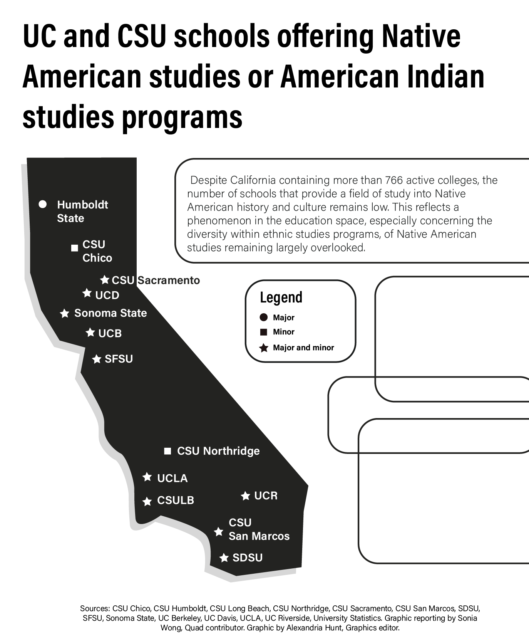While nearly nine million people in the United States identify as at least partially American Indian or Alaskan Native according to a 2021 U.S. Census Bureau survey, there is often a misrepresentation and a lack of curriculum surrounding Native Americans in U.S. education.
According to a study by the University of Southern Mississippi, Native Americans are often portrayed with stereotypical images and outdated information in children’s books. As a result, the study shows that many young non-Native children believe inaccurate concepts about Native Americans.
The director of the UCLA American Indian Studies Center, Shannon Speed, said Native American history is not adequately covered in public education or education at all levels.
“One problem is that there’s not nearly enough education, so there simply isn’t curriculum included at the K to 12 level,” Speed said. “And it’s entirely possible to go all the way through your college degree and never take a single class that refers to Native Americans.”
American Indian studies professor Paul Kroskrity said the education system could be more understanding of the diversity of Native American culture, such as acknowledging various tribal groups.
“Part of the thing about Native communities is that even though we talk about Native Americans as if they are one people, they are actually from hundreds of different tribal groups,” Kroskrity said. “And they often have very different histories within those groups.”
According to a study published by the University of Chicago Press journals, the lack of Native American professors, researchers and administrators create a lack of role models for future generations, further purporting the negative stereotype that Native Americans lack the capacity for higher learning.
Stella Nair, an associate professor of American Indian studies, said there should be a higher number of people teaching Native history in academia, considering its long history, and that academia still lacks representation of Native or Indigenous faculty.
“A huge problem is that there are very few people who teach on anything to do with American Indian studies,” Nair said. “But if you think about the tens and tens and tens of thousands of years of Indigenous history across the Americas and how few faculty we have covering that, it’s really horrific.”
A lack of professors and educators that teach courses relating to the history of Native Americans can also lead to students, from a young age, who are unaware of or misunderstanding of Native American culture and traditions.
American Indian studies professor Tara Browner said students have narrow understandings of Native American history and are often unaware of significant historical events, such as knowing the Battle of the Little Bighorn but not the Trail of Tears.
“It’s interesting because what they seem to get are kind of these high points of things,” Browner said. “Because I’ll ask them other things like, ‘Do you know about the Trail of Tears?’ And I’ll get this blank look.”
Jaime Geronimo Vela, an anthropology graduate student, said the U.S. education system can also overlook the violence and discrimination that Native American communities have faced.
“They didn’t know about boarding schools. They didn’t know about the genocide that happened. They didn’t know about us not being citizens until 1934. Not being able to really vote until 1964. They didn’t know reservations were originally prisons,” Vela said. “The elders were alive when that was going on, so they can’t forget.”
In light of insufficient educational material covering Native American communities, Kroskrity added that he wants to see more efforts in establishing university programs that aim to educate students.
“One of the things that’s good … is that we’re seeing so many universities want to establish programs in American Indian Studies,” Kroskrity said. “I’m hoping that this is going to be one of those trickle-down things, where what we’re learning now and teaching at the university levels will eventually become part of what we see more routinely taught in the lower grades too.”
For Speed, including more Native American community members and voices in educational spaces can increase inclusion and foster a better understanding of Native Americans.
“I think it would be great if university campuses designated public spaces that treat Native issues, that allow Native communities to come on to the campus and be part of the campus community,” Speed said.
Amid a lack of educational resources that aim to inform people about Native American culture and history, Bruins may find it helpful to learn from Indigenous and Native peoples themselves. For example, the American Indian Studies Center for Native American Bruins at Campbell Hall provides resources that foster graduate and undergraduate education on Native studies.
“Go out and learn about the Native peoples whose land you’re on and what are their contributions. If you’re in Los Angeles, that’s going to be the Gabrielino you’re talking about, or the Fernandeño Tataviam,” Speed said.


Comments are closed.